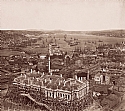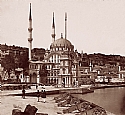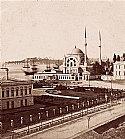Books
FROM KONSTANTiNiYYE TO İSTANBUL
PHOTOGRAPHS OF THE RUMELİ SHORE OF THE BOSPHORUS
FROM THE MID-19TH TO THE 20TH CENTURY
The garden of paradise to all who behold it
Those who once enter want never to leave
Sing not the praises of India and Cathay and Khotan,
For here lies the honorable gift they call Stanbul.
[Abdüllatif Latîfî [1491-1582]; See Ercan 2002: 10; Koç 1999a: II. 43-44]
"Photographs cannot lie, but liars can take photographs," says Lewis Hine [Burke 2003, 21]. We do not know if the people who took the photographs you are about to see in this book were liars in real life. However, their images reflect the reality of Istanbul in a certain period. Tales and legends may become distorted over time, but visual documents enable us to come face to face with the truth. There are cities that are invisible, hidden in nature or invented by our imagination. Cities that live with us; cities that belong to us. Then, there are the eternal ones. The ones that belong to everyone and to no one. Those cities embrace us and generate our memories. We live our recollections in those cities and we coexist with them. A dream world manifests itself unexpectedly and we migrate to this world together. As Latîfî pronounces it, for us, this city is Istanbul. Even if it is demolished repeatedly by those who create it and those who live with it, the sight of its ruins fears no one; it is rebuilt.
Aristotle defines urban life as “living together for a noble purpose.” Since its creation, humanity’s most important discovery is urban life. Today, everything can be regarded as the consequence of a collective life, generated by an urban way of living. The epitome of Humanity’s greatest success over thousands of years is life in the metropolis.
Suddenly I arrived at a city, I saw that this could be created
For even I was created, from materials of stone and earth.
[Hacı Bayram-ı Velî [1352-1430]; See Azamat 1999: 498-501]
Cities are made up of structures shaped by the hands of man. Though originally built for shelter, these structures are eventually developed into works of architecture. Apart from written sources, architecture is indisputably the second most significant method of interpreting history for the future. In evaluating the past, we see that in some instances, even writing may perish or remain indecipherable, yet architecture maintains its existence as a cultural document. A structure projects an image from the past into the future. It is a work, which has made a statement for centuries and will want to speak for itself for centuries more to come.
Archaeological excavations, past and present, indicate that for thousands of years, cities have been formed in layers upon one another. Any given culture dominating a city reconstructs it with a new architecture and a new vision. Pagan temples are built upon former sacred areas, which are replaced by churches for a while, and the same areas are then bedecked with mosques. A city is a living organism and it evolves in conjunction with the cultural ties of the people who govern it. When a city can no longer produce its own culture, the majority of its inhabitants are imprisoned in the past; they identify themselves with the familiar or presumed elements of an earlier culture. Conversely, another group imports examples of cultures, which they deem to be original, in an attempt to fill the void of the existing culture that has lost its creativity. These two perceptions generate an intense conflict between various segments of society until a new culture manifests itself.
Conflict is a dynamic; if we can set this conflict in motion within a culture of reconciliation, without making it a war, then we may facilitate the emergence of a new culture. Otherwise, the ongoing conflict eventually exhausts the people, brings life to an unbearable impasse and leads to the eventual destruction of the city.
Today’s Istanbul is a city, which no longer holds the privileges it enjoyed for thousands of years. Not only has it lost its status as the capital, but it has also the advantage of being the center of administration and commerce for an immense hinterland. Thus, in order to survive, it is obligated to produce a new way of being, a new culture. The only way to create a new culture is to generate solutions for contemporary living, based on the cultural texture of the past. It is impossible to develop a new future for a city from temporary and speculative affirmations, which are not based on reality, devoid of a cultural infrastructure, and are opposed to the accumulation of knowledge. People who reject their history cannot be expected to uphold the architectural documents and know-how of a past they refuse to be a part of. The past is a whole, with our sins and our good deeds. We do not have the luxury to extol what we like and reject what we do not. Our perception of the past as a trap, with series of capitulations that preempts any kind of development, prevents our city and our selves from integrating with the world.
In the past, Istanbul gradually retreated from global commerce and became more and more introverted. During the creation of a modern Turkey, based on the principles of nationalism, it not only lost its long-standing status as the center of an empire, but also came to be perceived as a common, provincial town. The plethora of colors acquired over centuries faded, giving way to a monotonous society, which lacked any sense of competition. This, and perhaps more, soon turned Istanbul into a large village in which people were encouraged to think and act the same way, for they would be ostracized otherwise. At no point in history, there ever has been, or ever could be, an urban life, which was isolated from competition or diversity of thought.
We began the Rumeli Shore portion of the Bosphorus adventure in Karaköy. The view of the port from the Bayezıd Tower is the first image: thousands of ships and an incredible state of activity… In 1887, Istanbul is the second largest seaport in the world. 23,742 tons of goods are loaded and unloaded on a daily basis [Müller-Wiener 1998: 132]. It is a commerce and transfer center covering a vast geographical area, ranging from the Danube basin to the Sea of Azov, from the Aegean islands to Egypt. The enormous volume of trade contributes greatly to the city. New ideas, new people, new values find their way in and gain acceptance through this kind of an interchange. The city prospers, and, much like today’s major global centers, becomes attractive for people who want to partake in this activity, irregardless of their religion, language and nationality, causing them to flow to the city with the hope of finding a place for themselves.
We witness within a short span of time an intense development and a changing silhouette in the area from Karaköy to Tophane and from there on to Dolmabahçe Palace. The villages, which begin in Beşiktaş and extend along the length of the Bosphorus, generally remain within the valleys and they appear as settlements independent of one another, with no visible organic ties with the city. Although the areas with a predominantly non-Muslim population, such as Arnavutköy, Bebek, Tarabya and Büyükdere may have an organic relationship with the city, Rumelihisarı, Yeniköy, İstinye, Sarıyer and Rumelikavağı still maintain a strong attachment to the past. In certain images, we see the structures about which we have written sources of information. Sinan, the Architect’s Karaköy Hamam, Nusretiye Mosque before its courtyard gave way to the tram line, Bayıldım Kiosk, the orderly appearance of Dolmabahçe Square during the reign of Sultan Abdulmecid, the caique-landing in front of the Muayede Salon, Neşetâbâd Palace at Defterdarburnu, Rumelihisarı’s Kaleiçi houses, Summer Palace Hotel and others.
We shall see many other things in viewing these photographs. Monumental mosques, sultans’ palaces, grand viziers’ yalıs, rickety wooden structures, naked hilltops, man-made groves, expectant fishing weirs, those beautiful piyades, or light rowboats, swaying in the waters of the Bosphorus… Photographs do not lie. Yet we are capable of lying. In the past, the Bosphorus was comprised of neatly organized buildings and the hillsides were covered with green; it was a portrait far more perfect than today… If our wisdom allows and if we are indeed capable, there is a lesson to be learned from these documents, which hold many clues for the future.
I will take this opportunity to express a certain regret. The people, who shall evaluate in the future, what we encounter in the now, will also want to see the structures adorning the Bosphorus, built during the past eighty years of the Turkish Republic. What will we say then? With the exception of the structures we inherited from Sedad Hakkı Eldem and a handful of architects who worked in dire conditions, what examples will we offer to the future generations? In the historic beauty of the Bosphorus, what gifts of our contemporary culture will we be able to present to them?
I sought to write the text for this book; as a person who was born and raised in Istanbul, particularly in a Bosphorus village like Kuzguncuk, I felt I owed a debt to this city that would be difficult to repay. My beloved friends Suna and İnan Kıraç were very understanding, liberating and supportive in accommodating my desire; I am grateful to them. It has taken me five years to bring to fruition the work I began in 2001. Sometimes I had no time, at other times the evaluation of a single photograph would take months. In the course of this labor, I spent nearly every Saturday and Sunday working at my desk. Instead of dedicating some of these cherished days and years to my family, I remained alone; a difficult person among his books. I owe a heart-felt gratitude to my beloved daughters Azrâ and Esrâ for their tolerance and to my wife Renan Genim for her boundless patience.
I would like to extend my infinite thanks and appreciation to Ahmet Abut, who collected the photographs that would be nearly impossible to obtain again, who constantly endeavored to ensure that they be preserved for the future as an archive, who sometimes infuriated me by sending me new frames that turned my work upside down; to Bahattin Öztuncay, whose endless assistance I was fortunate to enjoy as a colleague in the stage of the evaluation of the photographs; to Lokman Şahin and his colleagues, who have provided every possible type of support and undertook my caprices with enormous tolerance; to Savaş Çekiç for his design of the book; to my beloved daughter Azrâ Genin who read and critiqued everything I wrote; to Belma Barış Kurtel, who followed me closely at every stage and read the text repeatedly; to Selmin Kangal and İsa Kayaalp for their corrections.















